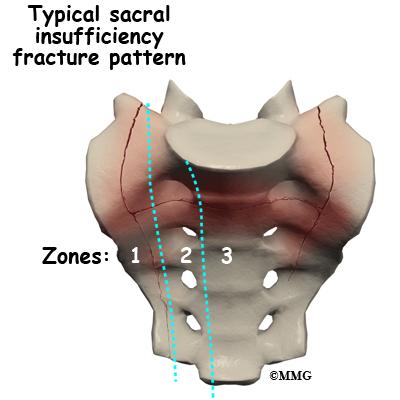Sacral Insufficiency Fractures

Overview
Sacral insufficiency fractures refer to bone injuries that occur in the sacrum, the large, triangle-shaped bone at the base of the spine. They are an uncommon but serious condition, often resulting from bone weakening due to osteoporosis, cancer, or radiation therapy. This guide provides crucial information about sacral insufficiency fractures, helping you understand its causes, diagnosis, and possible treatment options.
Types
There are no specific types of sacral insufficiency fractures. However, they can vary in severity and location within the sacrum, which can impact treatment approaches and recovery times.
Causes
Sacral insufficiency fractures are commonly a result of:
-
- Advanced age: As we grow older, our bones naturally lose strength, leading to conditions like osteoporosis, which increases the risk of fractures.
-
- Osteoporosis: This bone weakening disease significantly raises the risk of fractures.
-
- Cancerous lesions or radiation therapy: Both can weaken the sacrum and make it more susceptible to fractures.
Symptoms
Symptoms associated with sacral insufficiency fractures can be somewhat subtle and are often mistaken for other conditions. Common symptoms include:
-
- Pain in lower back or buttocks
-
- Instability or difficulty walking
-
- Pain that worsens when standing or walking, but improves with lying down
Less common symptoms may include:
-
- Numbness or weakness in the lower limbs
-
- Bowel or bladder dysfunction
Diagnosis
Diagnosis of sacral insufficiency fractures involves a combination of a physical examination, patient history, and imaging tests such as:
-
- X-ray: To visualize bones.
-
- Computed Tomography (CT) scan: For a more detailed view of the sacrum.
-
- Magnetic Resonance Imaging (MRI): To detect bone marrow swelling and other signs of fractures.
Treatment Options
The treatment for sacral insufficiency fractures varies based on the severity of the fracture and the patient’s overall health status. Here are the two main treatment categories:
-
- Conservative Treatment: Non-surgical treatments include pain management with medications, physical therapy, and using supportive devices like walkers or canes. Conservative treatment also includes addressing underlying issues like osteoporosis.
-
- Surgical Treatment: Surgery, such as sacroplasty (where cement is injected into the sacrum to stabilize the fracture), might be required in severe cases or when conservative treatments fail.
Living With Sacral Insufficiency Fractures
Adjusting your lifestyle can help manage sacral insufficiency fractures and prevent future injury.
-
- Stay Active: Gentle exercise can help strengthen the bones.
-
- Diet: A balanced diet rich in calcium and vitamin D is essential for bone health.
-
- Medication Management: Follow your doctor’s guidance regarding pain medication and any prescribed medication for osteoporosis.
When to Seek Help
Patients should seek immediate medical attention if they experience sharp, severe lower back or buttock pain, especially if it’s coupled with symptoms such as tingling or loss of sensation in the legs, or issues with bladder or bowel function. These symptoms can indicate a severe fracture or nerve damage. Also, individuals with known conditions like osteoporosis, who experience new or increased lower back pain, should get evaluated for possible sacral insufficiency fractures. If you notice any of these symptoms, don’t hesitate to contact a healthcare provider for accurate diagnosis and treatment.
